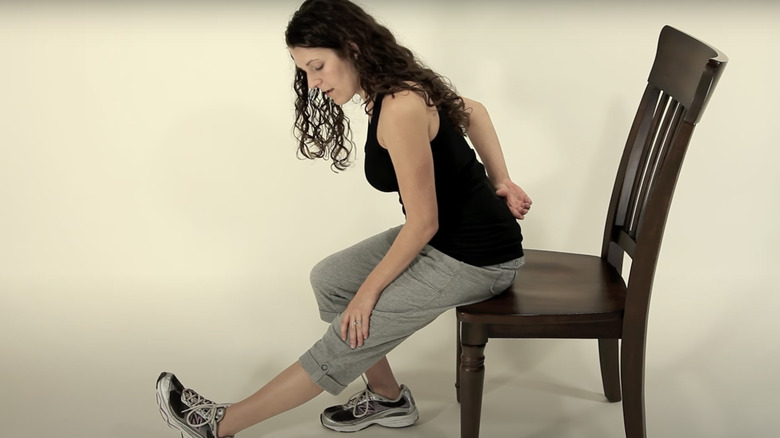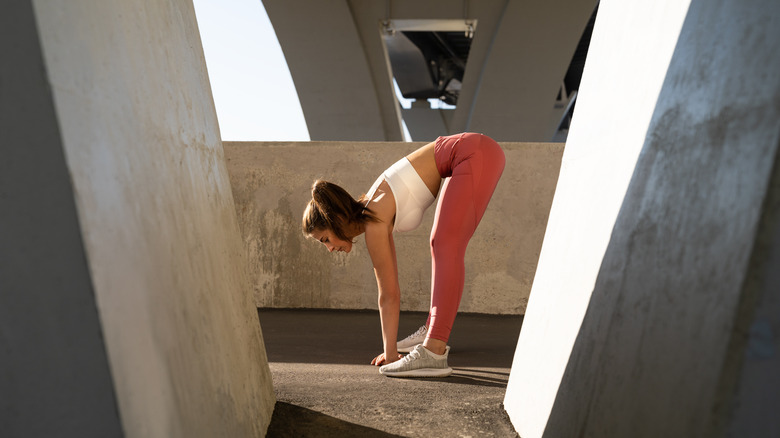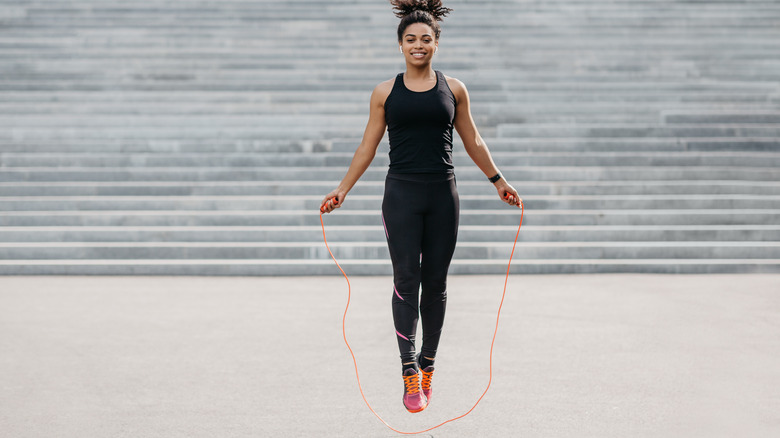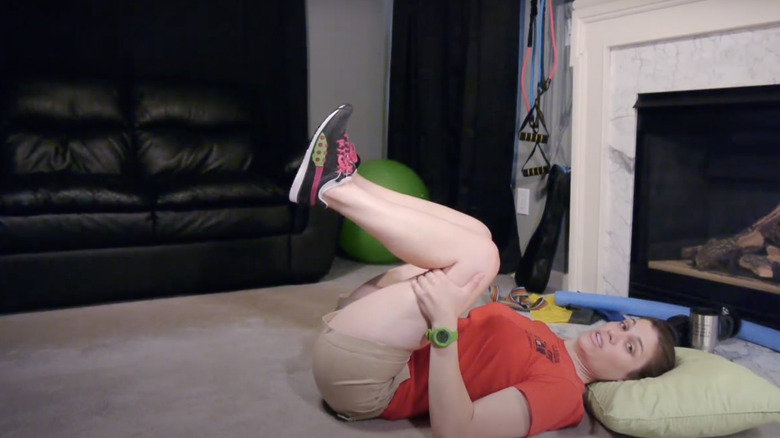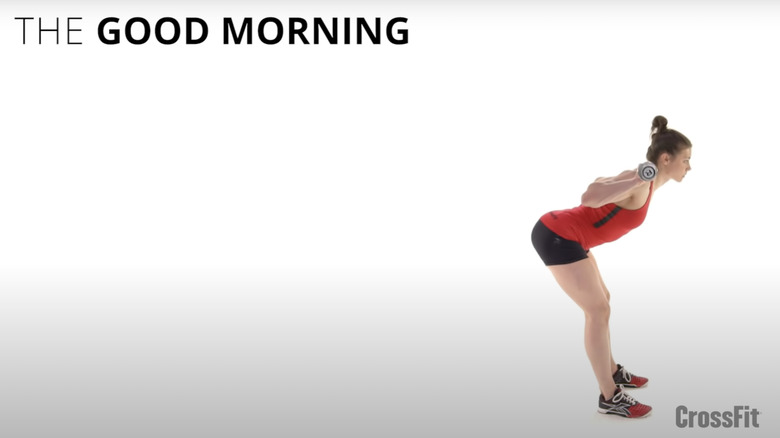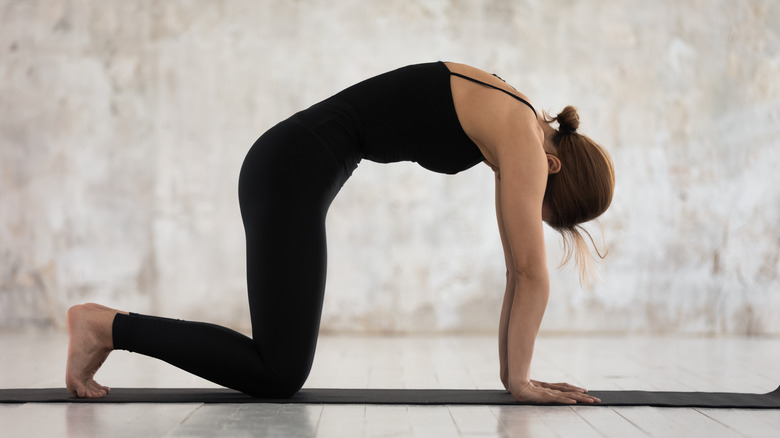Exercises To Try And Exercises To Avoid If You Have A Herniated Disc
Our spines are amazing things. The row of bones that runs from our tailbones to our heads acts as the foundation of our skeleton and our movement and allows us to bend, stretch, flex, and rotate easily. But given that our spine is involved pretty much any time we do anything, it's not entirely surprising that it can become damaged. And when a spine injury rears its head, it could well come in the form of a herniated disc, characterized by a tearing or puncturing of the discs between our spinal bones, which serve to keep our movement fluid (per Cleveland Clinic).
Herniated discs can be particularly common in middle-aged people, and roughly two out of 100 people experience them every year. And they're not fun, folks. Herniated discs can lead to a range of aches and pains, and they can make movement pretty challenging. That's why, when you have a herniated disc, you need to be cautious around exercise and prioritize forms of movement that aid your recovery and the movement in your spine instead of making it worse.
But how do we know which exercises are good for us and which aren't? Luckily, we've got the best and the worst of them right here.
How do herniated discs occur in the first place?
It's easy not to think about our backbones until something goes wrong, but we should take a moment to marvel at how amazing the spine is. Made up of vertebrae and the discs between them, this series of bones provide us with flexibility and supports our posture (per University of Maryland Medical Center).
Our spines aren't invincible, however, and over time, the discs between our bones deteriorate, with the ligaments that surround them also losing function and flexibility as we are, according to the American Association of Neurological Surgeons. When this happens, our spinal discs are more prone to tearing or leaking, which results in herniation when we twist or strain them, even mildly. This usually happens to the discs in our lower back and can also occur in our necks. It's worth bearing in mind, however, that herniated discs can happen even when your back is in relatively good shape and your ligaments strong, through injuring your back or working it too hard. This is why, even if you don't have a herniated disc, it's important to care for your back properly and not work it too roughly.
Try: seated chair stretch
Our upper body is supported by our lower body, and this support becomes even more important when you have a herniated disc in your lower back (per Medical News Today). The hamstring muscles are especially instrumental in this, and stretching exercises can assist in keeping your legs strong and better equipped to support your back.
A seated chair stretch is a safe stretch that can be done anywhere that you can find a chair. Sit with your back straight and both feet planted on the ground in front of you, and then straighten out one of your legs, heel resting on the floor. Then, bend forward at the hips, with your upper body coming over your straight leg while ensuring that your upper body doesn't crunch forward. You should start to feel a stretch through your hamstring as you do this. Lean as far as is comfortable (stopping if you feel any pain or discomfort), and then hold the position for up to 30 seconds before returning to your first position. Switch feet, and repeat with the other leg. You can then repeat the stretch on both sides should you feel you need more.
Avoid: standing hamstring stretch
Your hamstrings are your best friend when you have a herniated disc, but not all hamstring exercises are created equal. And performing a standing hamstring stretch could actually create further problems for your back, according to Spine-Health. When you do a standing hamstring stretch, your upper body can get involved a little too much, introducing a bend into the spine that puts stress on your discs. This can not only be uncomfortable for your back and slow down healing but can also mean that you don't get as good a stretch in your legs.
To avoid this, perform a seated hamstring stretch, or do one while lying on the floor. Position yourself in an open doorway, and lie down with your legs through one side of the doorframe and your body through the other. Lift the leg that you're stretching, and position it against the frame, keeping it as straight as possible. Ensure that you're not trying to overexert yourself here: If you feel like the stretch is too intense, shift your body so that it's further away from the frame. Hold the stretch briefly, and then repeat with the other leg. It's also possible to do this stretch with your leg against another sturdy object, like a sofa, a table, or an exercise rack.
Try: walking
Walking is often skipped over when it comes to exercise in favor of more intense practices, but honestly, there are few things better for your health than a good walk. As well as giving a boost to your cardiovascular health, regular walking can deliver mood-enhancing benefits, help to protect your brain health, and could even allow you to live longer, according to the Arthritis Foundation.
And if you have a herniated disc, walking could be one of the best exercises you could do. Walking provides you with a low-impact workout that doesn't put too much stress on your spine, thereby limiting your discomfort as you stay active, as Barricaid states. It's important to bear in mind that while it can be tempting to limit your mobility while you're recovering from a herniated disc, regular activity maintains your joint mobility and stops your muscles from losing their strength. Bear in mind, though, that while walking is a great exercise to do, you probably don't want to embark on a 10-mile trek straight off the bat. Start slow, aiming for around 10 minutes of walking each day, and slowly build up to around half an hour of regular exercise daily (per Spine Universe).
Avoid: running
Running can be a great cardiovascular workout, but if you have a herniated disc, it's best to give it a wide berth. When you head out for a jog or a run, you're going to be pounding the pavement with every step you take, over and over again. And the constant impact of your steps is absorbed through your spine, and specifically your discs, as Livestrong states. When one of your discs is herniated, however, all of the stress you're placing on your spine can cause additional discomfort and pain and potentially prolong the amount of time you take to heal. And while running at a regular gradient may be bad enough, it's even worse if you're running uphill, as the forward bend in your spine will exacerbate the stress on it.
If you're a keen jogger, though, it's not all bad news –- once you recover, you should be able to resume your running regimen. A review of 10 different cases of herniated discs in runners found that after receiving treatment involving different exercises, anti-inflammatory medicine, and rest, they were then able to slowly reintroduce running back into their routine. Eventually, nearly all of them returned to regular exercise and running.
Try: standing row with resistance band
Given that muscle-strengthening exercises often heavily involve the back, it's understandable that you might be wary of resistance training when you have a herniated disc. But if it's done gently and safely, keeping your muscles active through certain exercises can be very beneficial if your back is injured. A standing row with a resistance band is a great way to do this, with the move potentially relieving spine pain while working your muscles and allowing you to reap the benefits of resistance training, which range from better muscle tone to better overall sleep to lower rates of cognitive decline (per Better Health).
Stand in front of a sturdy object, like a lamp post or an exercise rack, and wrap a resistance band around it. Hold one end of the band in each hand in front of your chest, ensuring that your spine is elongated, with a slight bend in your knees. Then, pull the resistance band towards you in a rowing motion until your elbows move behind you on either side. Perform this movement for 10 reps, and then rest before your next set.
Avoid: lifting heavy weights
If you consider the gym your second home, you might be tempted to try and carry on with your weight training routine even if you have a herniated disc. But if you're in the habit of training hard, we'd seriously advise against it. Moves that involve bending forward or pushing weights upward (and let's face it, there are a lot of them) create stress through your spine, which may then make your symptoms worse, as Livestrong points out. This means that moves like overhead lifts, Romanian deadlifts, and burpees are all off the table, as Muscle & Fitness states.
That's not to say that you can't do any weight training while you have a herniated disc, however, but avoiding moves that compress or bend your spine is highly advised. It may also be the case that you can adapt your existing moves to remove any need for forward bends. Finally, whether you have a herniated disc or not, you must always perform your weightlifting moves with proper form, avoiding placing your spine in awkward or unnatural positions. Make sure you're never lifting weights in a jerking movement, and always lift weights that you know you can handle.
Try: cycling
The allure of the open road, the wind whipping through your hair, the wheels whizzing around under your body ... There's nothing quite like cycling. And as it turns out, if you're experiencing issues with a herniated disc, it could be the ideal exercise for you. Cycling provides an excellent cardiovascular workout while keeping things low impact, removing the repeated shock to your spine that can come with other exercises (per Spine Universe). Regular cycling may also assist in improving the overall strength of your spine and keep your discs healthy, states sports physiotherapist Bianca Broadbent via Bicycling.
It isn't all good news, however. In some cases, cycling can make your likelihood of developing a herniated disc higher due to the bent-over position you adopt on a bike, creating pressure on your spine. This is especially common in the lower back as that's where the bend is usually most pronounced when you're biking, says certified strength and conditioning specialist Menachem Brodie. To avoid this, considering your cycling position is key. "You want your spine in a healthy position that doesn't strain those discs in your lower back," states Boulder Center for Sports Medicine founder Andrew Pruitt. Try to seek out an anatomical saddle, too, to shift your weight slightly forward and reduce pressure on the spine.
Avoid: jumping rope
The benefits of jumping rope regularly are numerous and pretty appealing, from keeping your heart health in check to encouraging greater bone density (per Nike). But what isn't appealing is how jumping rope might affect your spine, especially when you have a herniated disc. It doesn't take a genius to work out that a jump rope routine involves jumping and a lot of it. But all of that jumping creates stress in your lower back, where herniated discs are most common, and will be seriously inhibitive to your recovery (per Spine-Health).
As you might expect, this doesn't just mean jumping rope is off the table, but any exercises that involve jumping, so those jumping jacks, squat jumps, and burpees that you've grown so fond of will have to take a back seat for a while. Instead, you should prioritize low-impact activities, like walking or light resistance training, that can keep you exercising without strain. For HIIT lovers out there, try out a low-impact back-friendly HIIT workout as designed by certified strength and conditioning specialist Charlee Atkins via Well+Good. Ensure, however, that any moves you're doing as part of a HIIT workout (or any workout) aren't causing pain, and if in doubt, talk to your physiotherapist or doctor.
Try: swimming
We'll never stop talking about how much we love swimming. This full-body workout works your muscles while boosting your heart health (per Better Health) and also helps to ease the mind after a long, stressful day. We didn't think we could love it any more -– until we learned that it's also the perfect exercise for people with herniated discs. Swimming allows you to work out your body without putting any impact on your spine and also assists in building back strength to better support your vertebrae and discs (per the Desert Institute for Spine Care). Swimming while you have a herniated disc may also bring down the inflammation in your spinal joints, as shown in a study published in Experimental and Therapeutic Medicine.
As with any exercise, while you have a herniated disc, it's important to be careful. Crucially, you should try to avoid any twisting motions through your hips and waist, as this can put your spine in an awkward position and make your pain worse. Ensure that you're not trying to match Michael Phelps' record in the pool, too, as working out too hard when you have a back injury can set you back. Keep your swimming strokes controlled, focusing on proper form, and if in doubt, take it down a notch, stopping entirely when you need a break.
Avoid: twisting exercises
Our spines can do a lot, but when it comes to twisting motions, they can get significantly less comfortable, and they can be especially impactful on the lower part of your spine, as Livestrong states. Unfortunately, this means that twisting movements impact the very region where herniated discs are most prone to develop and may even prompt herniated discs in the first place.
For this reason, it's very much recommended that you keep exercises that require you to twist out of your rotation. This means moves like Russian twists or yoga poses that twist through the spine should be avoided. Adding weight into a twisting scenario will only increase the stress and pressure on your spine, so nix any moves that twist while using kettlebells, dumbbells, or medicine balls, like wood chops or medicine ball rotational throws. It's worth remembering, too, that it's not just explicit workout moves that involve twisting that could be dangerous, but any twisting motions you're performing in your everyday life, like picking up groceries and putting them in the pantry, could both aggravate and cause herniated discs (per the Mayo Clinic).
Try: back flexion stretch
It might seem logical to avoid movements that involve your back when you have a herniated disc, but in fact, you kinda need to do the opposite. By performing back exercises, you're able to strengthen your back muscles, which then provide better spinal support, as Medical News Today points out. A back flexion stretch is a great way to do this, activating your back muscles without creating stress on your discs and stretching out your spine simultaneously.
A back flexion stretch is super simple to perform, too. Grab an exercise mat, and lie flat on your back. Draw your knees up and in towards your chest, and then use both of your hands to squeeze your knees in while simultaneously curling your head up to meet them. In doing so, you should feel a stretch through the back, particularly the lower back. Hold this position for up to 30 seconds before releasing your legs and resting. Repeat several times. While this move is a simple way to develop back strength and flexibility, it's still important to consult with your doctor about any exercises you're doing and whether they'll impact you negatively in your specific circumstances.
Avoid: good mornings
The "good morning" exercise is a staple of at-home workout videos and personal trainers' repertoires, but if you have any concerns about your back, it's highly recommended you avoid doing them. The forward-bending motion of good mornings creates a huge amount of strain on your lower back, which is only added to by the weights that traditionally accompany the move, placed on the shoulders (per Spine-Health). As herniated discs are often situated in the lower back, this will do nothing but make things worse –- and even if you don't have a herniated disc, it's not the safest move out there.
Help is at hand, though, with a variation of good mornings that will alleviate pressure through your spine. Enter the "waiter's bow." Stand in front of a bed or an exercise bench, and then hinge forward at the hips, putting your hands on the surface in front of you. Then, let your body move back to standing while activating the glute muscles and keeping your lower back in its natural curve, not flattening or arching. The focus should not be on your torso and upper body but on your glutes and hips.
Try: yoga
Yoga is one of our favorite ways to work out, and if you have a herniated disc, you'll love it too. The workout practice can offer some pain relief in your back and is an awesome way to stay strong and mobile while your spine is recovering, as Spine Universe states. Additionally, yoga offers a host of benefits to your body that will benefit your back and support its healing, helping to strengthen your core (which delivers stability and postural support) and increasing blood flow around your body and to your herniated disc, as Vive Health says.
Certain moves may be more beneficial than others, and poses that emphasize movement through your lower back could be perfect to include in your practice. Try a yoga flow that includes cobra, locust, and downward dog poses, all of which can help to open your spine up and get it moving. The triangle pose can also be a great pose to incorporate, which delivers a premium stretch through your back muscles while also toning your lower body. Importantly, though, even though these moves are better for people with herniated discs, the main thing to do is to listen to your body. If you feel any pain or discomfort, stop what you're doing immediately.
Avoid: certain yoga poses
Although yoga may be one of the best ways to keep active while you're recovering from a herniated disc, it's not all smooth sailing. It's vital to remember that there are plenty of poses that your back definitely won't enjoy and which risk placing excessive pressure on your spinal discs, making your condition worse (per Spinalogy Clinic).
The main culprits are poses that require you to bend or fold forward, as well as those that twist your spine. The big toe pose and seated forward folds are, therefore, off-limits, as the full forward bend they necessitate will place a lot of pressure on your spine. It's also best to avoid rabbit and cat-cow poses, which arch the back significantly, resulting in compression. The most important thing to remember if you're attending a yoga class is to let your instructor know that you're experiencing back issues. Not only will they be able to keep an eye on you during the class and potentially offer adaptations that are more back-friendly, but can also assist you in using yoga blocks, straps, or blankets to make your flow easier (per Yoga Journal).



